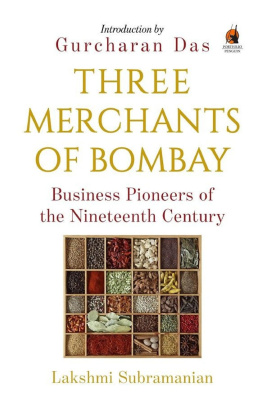Lakshmi Subramanian - Three Merchants of Bombay: Business Pioneers of the Nineteenth Century
Here you can read online Lakshmi Subramanian - Three Merchants of Bombay: Business Pioneers of the Nineteenth Century full text of the book (entire story) in english for free. Download pdf and epub, get meaning, cover and reviews about this ebook. year: 2016, publisher: Penguin UK, genre: Politics. Description of the work, (preface) as well as reviews are available. Best literature library LitArk.com created for fans of good reading and offers a wide selection of genres:
Romance novel
Science fiction
Adventure
Detective
Science
History
Home and family
Prose
Art
Politics
Computer
Non-fiction
Religion
Business
Children
Humor
Choose a favorite category and find really read worthwhile books. Enjoy immersion in the world of imagination, feel the emotions of the characters or learn something new for yourself, make an fascinating discovery.
- Book:Three Merchants of Bombay: Business Pioneers of the Nineteenth Century
- Author:
- Publisher:Penguin UK
- Genre:
- Year:2016
- Rating:3 / 5
- Favourites:Add to favourites
- Your mark:
- 60
- 1
- 2
- 3
- 4
- 5
Three Merchants of Bombay: Business Pioneers of the Nineteenth Century: summary, description and annotation
We offer to read an annotation, description, summary or preface (depends on what the author of the book "Three Merchants of Bombay: Business Pioneers of the Nineteenth Century" wrote himself). If you haven't found the necessary information about the book — write in the comments, we will try to find it.
Three Merchants of Bombay: Business Pioneers of the Nineteenth Century — read online for free the complete book (whole text) full work
Below is the text of the book, divided by pages. System saving the place of the last page read, allows you to conveniently read the book "Three Merchants of Bombay: Business Pioneers of the Nineteenth Century" online for free, without having to search again every time where you left off. Put a bookmark, and you can go to the page where you finished reading at any time.
Font size:
Interval:
Bookmark:

Trawadi Arjunji Nathji,
Jamsetjee Jeejeebhoy and Premchand Roychand
Doing Business in Times of Change
THE STORY OF INDIAN BUSINESS
Foreword by
Gurcharan Das

ALLEN LANE
an imprint of
PENGUIN BOOKS
THE CRAVING FOR adventure and the love of profit are inherent in human nature. Hence they say exchange is natural and all-pervasive. But then, why does the commercial spirit flower in some places and at certain times, and not in others? Lakshmi Subramanian has narrated here, with elegance, the stories of three legendary merchant princesTrawadi Arjunji Nathji, Jamsetjee Jeejeebhoy and Premchand Roychand. In doing so she has breathed life into the business world of western India in the latter half of the eighteenth and the first half of the nineteenth centuriesa most unlikely time for the rise of animal spirits in the disturbed, lawless, period of transition between the decline of the Mughal empire and the rise of the British Raj.
The relationship between commerce and the rise of cities and prosperity is an exciting tale that goes back in time to when the city first emerged in human history. It also goes to the heart of the question of wealth and poverty of nationswhy some grow rich and others remain poor. These are the sort of questions that engage our unique multi-volume history of Indian business.
Three Merchants of Bombay is the fourth book in Penguins The Story of Indian Business. The series seeks to unearth great ideas in business and economics that have shaped commerce in the Indian subcontinent while entertaining us with the romance of the high seas and the adventure in the bazaars. Leading contemporary scholars closely examine, in this series, historical texts, inscriptions and records, and interpret them in a lively, sharp and authoritative manner for the intelligent reader who may not have prior background in the field. Each slender volume offers an enduring perspective on business enterprise in the past, avoiding the pitfalls of simplistically cataloguing a set of lessons for today. The value of the exercise, if we are successful, will be to promote in the reader, a long-term sensibility which can help to understand the material bases for our present human condition and to think sensibly about our economic future. Taken together, the series as a whole celebrates the ideal captured in the Sanskrit word artha meaning material well-being, which was one of the aims of classical Indian life.
The first three books were published in early 2012. The series began with Tom Trautmans sparkling interpretation for our times of the renowned treatise on the science of wealth, Arthashastra, which was authored over 2000 years ago and is considered the worlds first manual on political economy. Our second work, Tirthankar Roys radiant account of the English East India Company, taught us, among other things, how much the modern multinational corporation is a child of the much-reviled Company. In the third book, Kanakalatha Mukund took us into the beguiling world of Tamil merchants, whose lives she drew from the epics, Silappadikaram and Manimekalai and other historical materials, up to the end of the Chola empire.
Following these books lies a veritable feastthree more books shall cover the ancient and early medieval periods: Gregory Schopen presents the Business Model of Early Buddhist Monasticism based on the Mulasarvastivada-vinaya; Himanshu Prabha Ray takes us into the maritime trading world of the western-Indian Ocean, along the Kanara and Gujarat coasts, using the Gujarati translation of the Sanskrit work, Lekhapaddhati; and Arshia Sattar recounts the brilliant adventures based on Kathasaritsagara and other sources in The Mouse Merchant among other tales. Then Scott Levi takes off from the early modern period to the modern one with the over 500-year-old saga of Multani traders in their caravans travelling through central Asia, rooted in the works of Zia al-Din Baranis Tarikh-i-Firuz Shahi and Jean-Baptiste Tavernier. Furthermore, the celebrated Sanjay Subrahmanyam and Muzaffar Alam transport us into the world of sultans, shopkeepers and portfolio-capitalists in Mughal India, while Ishan Chakrabarti traces the ethically individualistic world of Banarsidas, a Jain merchant in Mughal times via his diary Ardhakathanak.
The feast doesnt end there. Chhaya Goswami dives deep into the Indian Ocean to recount the tale of Kachchhi enterprise in the triangle of Zanzibar, Muscat and Mandvi from 1750 to 1900. Tom Timberg revisits the bold, risk-taking world of the Marwaris, and Raman Mahadevan describes Nattukottai Chettiars search for fortune. Then, Vikramjit Banerjee presents, through the works of Gandhi, Vivekananda, Nehru, Ambedkar and others, the competing visions of prosperity among the men who fought for Indias freedom in the early twentieth century. Finally, Medha Kudaisiya rounds up the series by breathing life into the debates surrounding the Bombay Plan, drawn by eminent industrialists in 194445 who wrestled with the proper roles of the public and private sectors.
The privilege of reading these rich and diverse volumes has left meone readerwith a sense of wonder at the vivid, dynamic and illustrious role played by trade and economic enterprise in advancing Indian civilization.
Lakshmi Subramanians three masterly biographical portraits raise many intriguing questions, and in this foreword I shall explore one of them: the relationship between the growth of commerce, the rise of cities, and the rule of law. Which comes first? Do cities grow because they offer peace and the rule of law to merchants? Or is it the other way around? Does the growth in commerce create the resources for investing in better institutions of security, law and order? The rise of Bombay and the decline of Surat in western India in the 100 years between 1750 and 1850 is a good laboratory in which to examine these questions.
Charles II, king of England, received Bombay as dowry on his marriage to the Portuguese princess Catharine of Braganza in June 1661. More than a hundred years later, the original seven islets were still a dreary settlement resembling the backwaters that flowed into it, according to our author. Then it rose spectacularly and went on to become the financial capital of India. How did this come to be, especially in the troubled and warlike conditions of the eighteenth centuryafter the collapse of the Mughal authority, the rise of the formidable Marathas, and the growth of English power?
The island city rose after the decline of Surat because it offered a competitive advantage in governance. When the opportunity came by way of external stimuli from the global economy, the dreary settlement responded. Bombay offered the classical conditions of peace, security, and the rule of law, and it did this far better than its competitors. No one has expressed this better than its first Governor, Gerald Aungier, when he promised Bombays inhabitants equality before the law and justice without fear, favour, in respect of persons. In a moving speech quoted by Mariam Dossal in Theatre of Conflict, City of Hope: Mumbai 1660 to Present Times, Aungier gave this advice to the first judge appointed in Bombay in 1672:
The inhabitants of this Island consist of several Nations and Religions to witEnglish, Portuguese and other Christians, Moores, and Jentue, but you, when you sit in this seat of Justice and Judgement, must looke upon them with one single eye as I doe, without distinction of Nation or Religion, for they have all an equal title and right to Justice and you must doe them all Justice, even the meanest person of the Island, and in particular the Poore, the Orphan, the Widow and the stranger
Font size:
Interval:
Bookmark:
Similar books «Three Merchants of Bombay: Business Pioneers of the Nineteenth Century»
Look at similar books to Three Merchants of Bombay: Business Pioneers of the Nineteenth Century. We have selected literature similar in name and meaning in the hope of providing readers with more options to find new, interesting, not yet read works.
Discussion, reviews of the book Three Merchants of Bombay: Business Pioneers of the Nineteenth Century and just readers' own opinions. Leave your comments, write what you think about the work, its meaning or the main characters. Specify what exactly you liked and what you didn't like, and why you think so.












